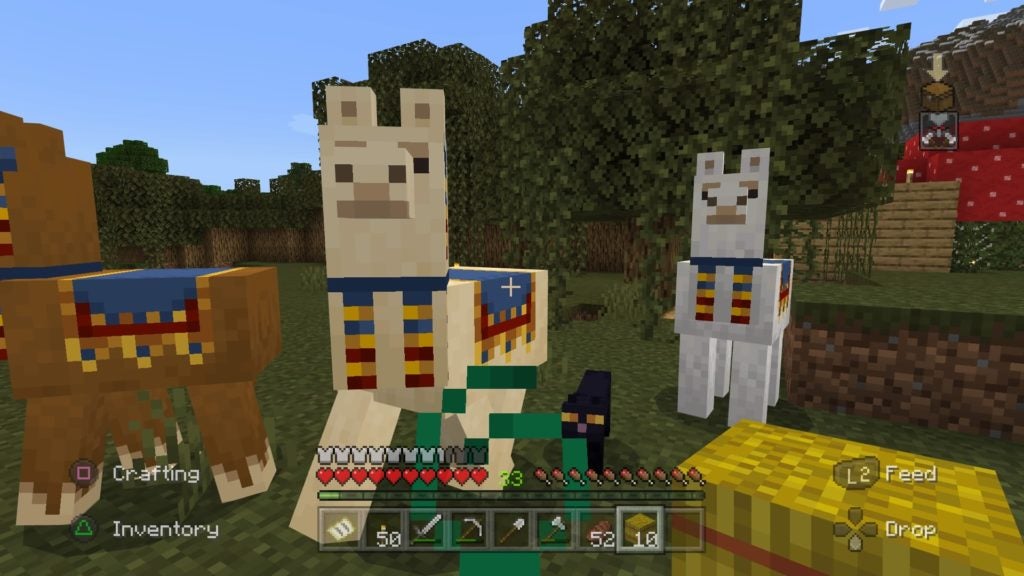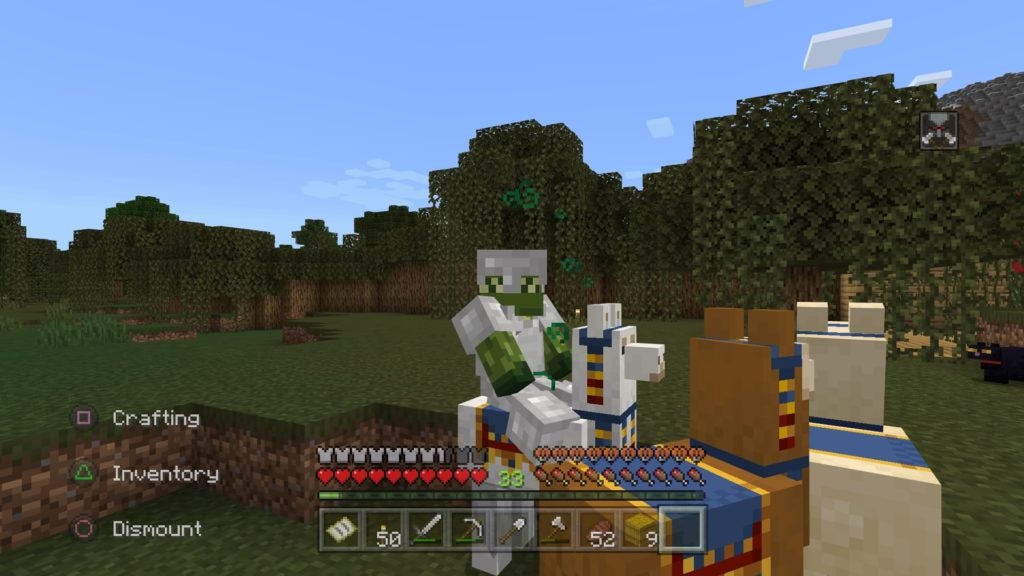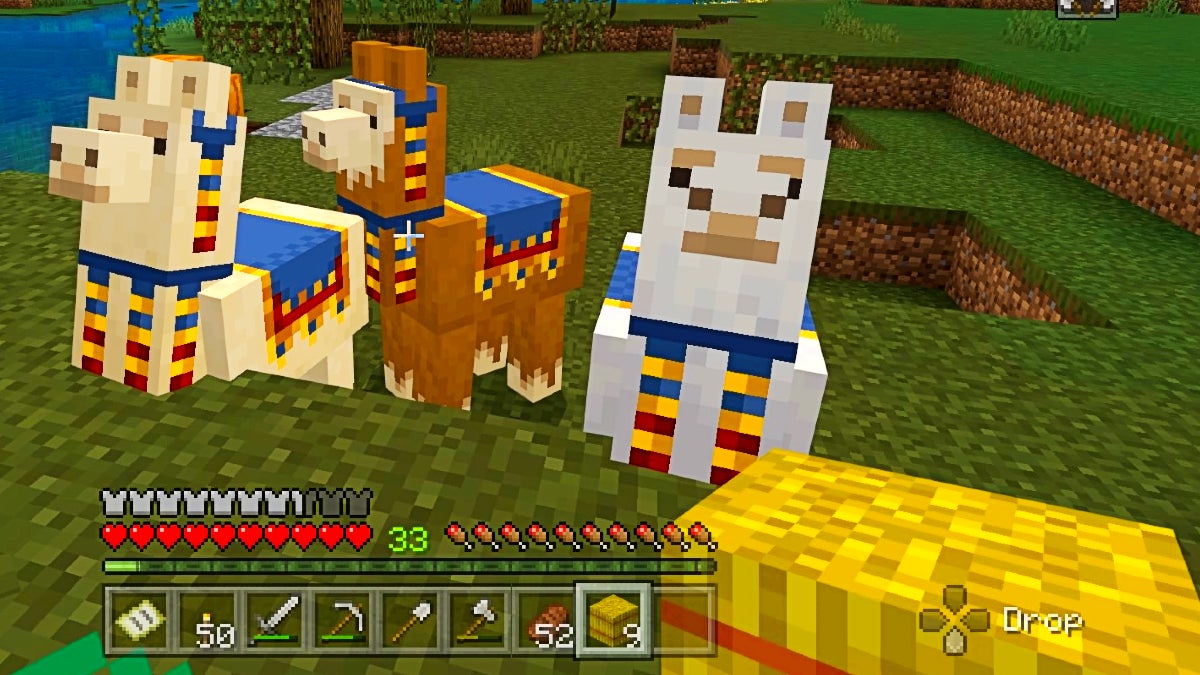If you want to increase the size of your Llama herd in Minecraft, you can breed them. However, you can only breed tamed Llamas with a specific kind of block. You’ll have to feed them their favorite food!
Table Of Contents
What You Need to Feed Llamas to Breed Them

You will need to feed Llamas Hay Bales to make them enter love mode. To make 2 Llamas mate successfully, you will need to get them relatively close together and then feed them both 1 Hay Bale. After that, they will nuzzle and then a baby Llama will spawn nearby a few seconds later. However, keep in mind that you can only breed tamed Llamas–wild ones will not enter love mode when fed.
About Breeding Trader Llamas
In the Java Edition of Minecraft, you can breed the Llamas of Wandering Traders if their original owner dies. However, you cannot truly own them yourself, despite still being able to use a Lead on them and use them for storage via a Chest. As such, you’re better off finding and taming wild Llamas, as you can control them when you ride them, unlike with the Trader Llamas.
In the Bedrock Edition of the game, you cannot breed Trader Llamas, though you can still interact with them in every other way. In both editions, 2 Trader Llamas always spawn on Leads alongside a Wandering Trader.
How to Tame a Wild Llama
It’s possible for you to come across wild Llamas in Windswept Hills and Savannah Plateau biomes. Additionally, in the Bedrock Edition, you can also find Llamas in regular Savannah biomes.
You can tame a wild Llama by riding them repeatedly. If you mount a Llama, and it bucks you off, you can try again after a few seconds. Each time you do this, you’ll have higher and higher odds of taming the Llama. Eventually, when you’re successful, you’ll see red hearts appear over the mounted Llama’s head that will indicate your success. You can increase the odds of taming a Llama by feeding them Wheat or Hay Bales before any taming attempt. Wheat will slightly increase your chances and Hay Bales will significantly increase your chances.
How to Breed Your Llamas for the Best Traits

Llama breeding works similarly to breeding Horses, in that baby Llamas can inherit appearance and statistical traits from their parents. However, the mechanics are simpler than that of Horse breeding due to Llamas being less complex mobs in Minecraft.
About Llama Appearances
The appearance of a baby Llama, as in the color of their fur, will always be the same as one of their parents. However, this is randomized, so that you can’t influence the look of a baby Llama besides choosing which adult Llamas to breed together. Llamas can only come in 4 colors: white, grey, cream, and brown.
About Llama Health
The Health stat inheritance works the same as with breeding Horses. Firstly, the Health stats of both parent Llamas are combined along with another randomly-decided third value. After that, the sum is divided by 3 to get the Health stat of the baby Llama. A Llama’s Health stat will always be between 15 to 30 Hearts. As such, if parent Llama A has 15 Hearts, parent Llama B has 25 Hearts, and the random value is 30 Hearts, the baby Llama’s Health stat would be 23 Hearts. You can check the Health of a Llama by riding it and counting the Hearts that appear above your hunger meter. However, Trader Llamas only have 10 Hearts of Health.
Here’s a little equation to represent this breeding example:
- (15 + 25 + 30)/3 = 23.3 [rounds down] = 23
About Llama Strength
How much Chest space a Llama will have when you use a Chest on it is directly determined by the Llama’s Strength stat. The number of Chest slots a Llama will have is always the value of their Strength stat multiplied by 3. This means that Llamas can have either 3, 6, 9, 12, or 15 Chest slots. The only way you can determine the Strength of a Llama is by using a Chest on them to see how many slots they get.
As for how baby Llamas inherit Strength from their parents, it works a bit differently than their Health stat. The Strength stat of a baby Llama will be chosen at random from values between 1 and the Strength stat of their strongest parent. Each potential value in the correct range has an equal chance of being chosen.
For example, if the strongest parent out of a breeding pair of Llamas has 4 Strength, there is a 25% chance of the baby Llama getting either 1, 2, 3, or 4 Strength. Comparatively, if the strongest parent Llama has 5 Strength, there will be a 20% chance for the baby Llama to have either 1, 2, 3, 4, or 5 Strength.


